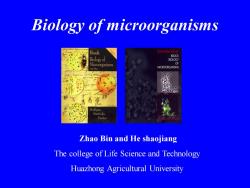华中农业大学:《食品微生物学》课程PPT教学课件(Food Microorganism)Chapter 1 Biology of microorganism

Biology of microorganisms Zhao Bin and He shaojiang The college of Life Science and Technology Huazhong Agricultural University
Biology of microorganisms Zhao Bin and He shaojiang The college of Life Science and Technology Huazhong Agricultural University

Introduction
Introduction

How to use your textbook? What’s the arrangement for the teaching? Why should we study microbiology
How to use your textbook? What’s the arrangement for the teaching? Why should we study microbiology

• Lecture (70 hours) • Laboratory practice (50 hours) • Mini-test (10 times) • Open-laboratory practice • Club activity Arrangement
• Lecture (70 hours) • Laboratory practice (50 hours) • Mini-test (10 times) • Open-laboratory practice • Club activity Arrangement

Why should we study microbiology? Two major reasons microbiology deals with many important practical problems in medicine, agriculture, and industry. Biochemical and genetic study As a basic biological science As an applied biological science Provides research tools
Why should we study microbiology? Two major reasons microbiology deals with many important practical problems in medicine, agriculture, and industry. Biochemical and genetic study As a basic biological science As an applied biological science Provides research tools

• the experimental basis of microbiology • the general principles of cell structure and function • the classification and diversity of microorganisms • biochemical processes in cells • the genetic basis of microbial growth and evolution • the ecological activities of microorganisms in nature. We will discuss:
• the experimental basis of microbiology • the general principles of cell structure and function • the classification and diversity of microorganisms • biochemical processes in cells • the genetic basis of microbial growth and evolution • the ecological activities of microorganisms in nature. We will discuss:

How to use your textbook ? The CHAPTER OUTLINE provides an overview of the chapter’s main concepts. SECTION NUMBERS keyde to page numbers provide easy reference points. The WORKING GLOSSARY provides definitions of important terms within each chapter. (Brock Biology of Microorganisms, Ninth Edition)
How to use your textbook ? The CHAPTER OUTLINE provides an overview of the chapter’s main concepts. SECTION NUMBERS keyde to page numbers provide easy reference points. The WORKING GLOSSARY provides definitions of important terms within each chapter. (Brock Biology of Microorganisms, Ninth Edition)

CONCEPT CHECKS summarize each section and provide quiz questions, so students can evaluate their understanding as they progress through the chapter. CONCEPT LINKS alert students to material that builds on previous concepts and provides a useful cross-referencing system for the entire book. Outstanding MICROGRAPHS are included throughout. TABLES have been redesigned to make key information even more accessible to students
CONCEPT CHECKS summarize each section and provide quiz questions, so students can evaluate their understanding as they progress through the chapter. CONCEPT LINKS alert students to material that builds on previous concepts and provides a useful cross-referencing system for the entire book. Outstanding MICROGRAPHS are included throughout. TABLES have been redesigned to make key information even more accessible to students

The ART in the ninth edition has been thoroughly revised, but still maintains the use of consistent color coding. BOLDFACED TERMS are defined in the Glossary. FEATURE BOXES provide additional, relevant information. Some take an historical perspective, some focus on techniques and applications, and others explore a text topic in greater depth
The ART in the ninth edition has been thoroughly revised, but still maintains the use of consistent color coding. BOLDFACED TERMS are defined in the Glossary. FEATURE BOXES provide additional, relevant information. Some take an historical perspective, some focus on techniques and applications, and others explore a text topic in greater depth

REVIEW QUESTIONS challenge the student’s mastery of chapter concepts. APPLICATION QUESTIONS allow students to test their analytical and problem-solving skills. APPENDICES provide useful tutorial and reference information
REVIEW QUESTIONS challenge the student’s mastery of chapter concepts. APPLICATION QUESTIONS allow students to test their analytical and problem-solving skills. APPENDICES provide useful tutorial and reference information
按次数下载不扣除下载券;
注册用户24小时内重复下载只扣除一次;
顺序:VIP每日次数-->可用次数-->下载券;
- 桂林医学院:《生物化学与分子生物学》课程教学资源(PPT课件)第九章 代谢调节.ppt
- 桂林医学院:《生物化学与分子生物学》课程教学资源(PPT课件)第八章 核苷酸代谢.ppt
- 桂林医学院:《生物化学与分子生物学》课程教学资源(PPT课件)第七章 氨基酸代谢.ppt
- 桂林医学院:《生物化学与分子生物学》课程教学资源(PPT课件)第六章 生物氧化.ppt
- 桂林医学院:《生物化学与分子生物学》课程教学资源(PPT课件)第五章 脂类代谢.ppt
- 桂林医学院:《生物化学与分子生物学》课程教学资源(PPT课件)第四章 糖代谢.ppt
- 桂林医学院:《生物化学与分子生物学》课程教学资源(PPT课件)第三章 酶化学.ppt
- 桂林医学院:《生物化学与分子生物学》课程教学资源(PPT课件)第二章 核酸的结构与功能.ppt
- 桂林医学院:《生物化学与分子生物学》课程教学资源(PPT课件)第二十三章 基因组学.ppt
- 桂林医学院:《生物化学与分子生物学》课程教学资源(PPT课件)第二十二章 常用分子生物学技术的原理及其应用.ppt
- 桂林医学院:《生物化学与分子生物学》课程教学资源(PPT课件)第二十一章 基因诊断与基因治疗.ppt
- 桂林医学院:《生物化学与分子生物学》课程教学资源(PPT课件)第二十章 癌基因与抑癌基因.ppt
- 桂林医学院:《生物化学与分子生物学》课程教学资源(PPT课件)第一章 蛋白质的结构与功能.ppt
- 桂林医学院:《生物化学与分子生物学》课程教学资源(PPT课件)第十七章 肝的生化.ppt
- 桂林医学院:《生物化学与分子生物学》课程教学资源(PPT课件)第十四章 基因重组与基因工程.ppt
- 桂林医学院:《生物化学与分子生物学》课程教学资源(PPT课件)第十三章 基因表达调控.ppt
- 桂林医学院:《生物化学与分子生物学》课程教学资源(PPT课件)第十二章 蛋白质的生物合成.ppt
- 桂林医学院:《生物化学与分子生物学》课程教学资源(PPT课件)第十一章 RNA的生物合成.ppt
- 桂林医学院:《生物化学与分子生物学》课程教学资源(PPT课件)第十章 复制.ppt
- 桂林医学院:《生物化学与分子生物学》课程教学资源(PPT课件)绪论.ppt
- 华中农业大学:《食品微生物学》课程PPT教学课件(Food Microorganism)Chapter 2 Cell Biology.ppt
- 华中农业大学:《食品微生物学》课程PPT教学课件(Food Microorganism)Chapter 3 The Prokaryotes.ppt
- 华中农业大学:《食品微生物学》课程PPT教学课件(Food Microorganism)Chapter 4 Eukaryotic Microorganisms.ppt
- 华中农业大学:《食品微生物学》课程PPT教学课件(Food Microorganism)Chapter 5 Viruses.ppt
- 华中农业大学:《食品微生物学》课程PPT教学课件(Food Microorganism)Chapter 6 Microbial Growth and Metabolism.ppt
- 华中农业大学:《食品微生物学》课程PPT教学课件(Food Microorganism)Chapter 7 Microbial Growth and Growth control.ppt
- 华中农业大学:《食品微生物学》课程PPT教学课件(Food Microorganism)Chapter 8 Bacterial genetics.ppt
- 华中农业大学:《食品微生物学》课程PPT教学课件(Food Microorganism)Chapter 9 Microbial Ecology.ppt
- 河北农业大学:《食品微生物学》课程教学资源(PPT课件)第一章 绪论(任课教师:贾英民).ppt
- 河北农业大学:《食品微生物学》课程教学资源(PPT课件)第二章 微生物主要类群的形态、结构和功能.ppt
- 河北农业大学:《食品微生物学》课程教学资源(PPT课件)第三章 微生物的营养.ppt
- 河北农业大学:《食品微生物学》课程教学资源(PPT课件)第四章 微生物的代谢.ppt
- 河北农业大学:《食品微生物学》课程教学资源(PPT课件)第五章 微生物的生长及其影响因素.ppt
- 河北农业大学:《食品微生物学》课程教学资源(PPT课件)第六章 微生物的遗传变异与菌种选育.ppt
- 河北农业大学:《食品微生物学》课程教学资源(PPT课件)第七章 发酵食品微生物.ppt
- 河北农业大学:《食品微生物学》课程教学资源(PPT课件)第八章 微生物与食品腐败变质.ppt
- 河北农业大学:《食品微生物学》课程教学资源(PPT课件)第九章 食品卫生微生物.ppt
- 广东轻工职业技术学院:《微生物学》课程教学课件(PPT讲稿)第一章 绪论(主讲:石琳).ppt
- 广东轻工职业技术学院:《微生物学》课程教学课件(PPT讲稿)第二章 微生物类群及形态结构.ppt
- 广东轻工职业技术学院:《微生物学》课程教学课件(PPT讲稿)第三章 微生物的营养.ppt
